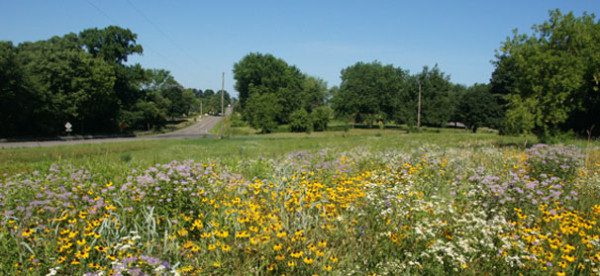
Dec 30, 2011Using Habitat to Increase Pollination
Many arthropods provide valuable ecosystem services, including those that humans depend on because they support food production. Insects have been estimated to provide Americans with natural pest suppression services worth nearly $4.5 billion annually and pollination services valued at nearly $3 billion annually. The scarcity of flowering and native plants within agricultural landscapes, the use of broad-spectrum insecticide and the loss or fragmentation of habitat have led to a decrease in beneficial insects, which puts us at risk of losing the natural ecosystem services they provide.
There has been a growing interest in the benefits of reintegrating natural habitats into agricultural landscapes as one strategy for conserving beneficial insects. Manipulation of the habitat in field margins or around cropped areas by establishing flowering plants and grasses can increase beneficial insect populations in agricultural systems. Modification or enhancement of the surrounding habitat may be an ideal approach to reverse the declining native bee populations observed in agricultural landscapes.
Research design and plot establishment.
In our recent experiments, we have worked with growers to establish wildflower plantings adjacent to blueberry crop fields. Recent research at Michigan State University has identified and measured the relative attractiveness of native Midwestern perennial flowering plants that can provide season-long floral resources for beneficial insects in agricultural landscapes. From the results, we have selected a set of herbaceous flowering plants that rank highly for their attractiveness to natural enemies and pollinators, and are listed under the Conservation Reserve Program: State Acres For Wildlife Enhancement.
Wildflower seeds were initially sown in early spring 2009 into plots that were prepared in fall 2008 adjacent to the crop fields. Wildflower seeds may also be sown during the fall, which is a more natural time for seed dispersal. It is advised to mow these wildflower plantings once a month during the first two years (alternating mowing half of the plot each month during 2010) to control annual weed growth and facilitate perennial wildflower establishment. The plantings should be left alone during the third year to allow wildflowers to bloom and set seed.
To determine whether wildflower plantings lead to improved pollination within adjacent fields compared to fields without this treatment, components of crop yield and the bee community were sampled in all fields involved in this project. Observations were made at each of the crop fields adjacent to the flowering and control strips, recording the identity and number of flower-visiting insects (bees, flies, wasps, etc.). During 2011, we observed more native, non-honey bee insect pollinators visiting flowers adjacent to wildflower plots compared to fields adjacent to control plots. Although the majority of pollinators visiting crop flowers were honeybees, there was a diverse group of non-honey bee insect pollinators observed as well.
Research results
There was little change in the insects or crop yield in the first two years after establishment. To measure pollination levels in the fruit crop, flower clusters were tagged, counted and covered with a fine nylon mesh bag to exclude insect pollination. After bloom, the number of fruit per bagged and open clusters were counted to determine the increase in percent fruit set due to insect pollination. At the blueberry sites, prior to harvest, fruit from tagged clusters from each of the five blueberry bushes at each location were collected and weighed to determine average fruit weight, and the number of mature and immature seeds were counted as a measure of pollination success.
Since it takes years for perennial wildflower plantings to establish and, subsequently, years for native bees to inhabit those areas, the first two years we did not see any difference in pollination. After the third year, we found an increase in percent fruit set and a slight increase in berry weight in fields adjacent to wildflower plantings.
We have also examined natural enemies and pest insects, and are seeing increasing levels of natural enemy activity inside fields next to plantings, without an increase in blueberry pests. This project will continue into 2012, to see whether the patterns are consistent over time.
For more information, click here.
By Brett Blaauw and Rufus Isaacs, Michigan State University
















